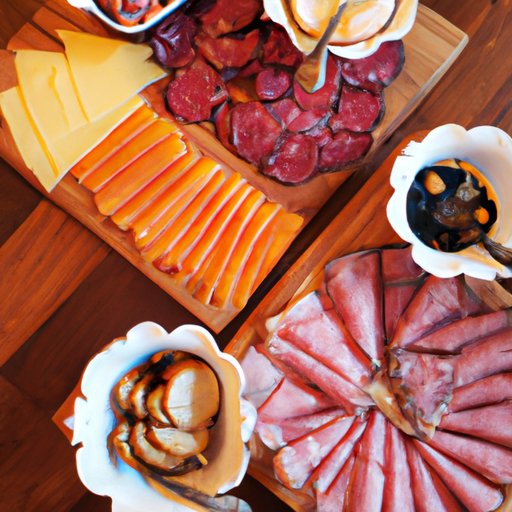
I. Introduction
Charcuterie boards have been growing in popularity, and it’s no surprise why. These delicious spreads allow for a beautiful presentation of various meats, cheeses, and other tasty goodies. With this step-by-step guide, you’ll be able to create an Instagram-worthy board that will have all your guests impressed. Here’s a breakdown of what’s to come:
II. The Art of Charcuterie: A Step-by-Step Guide to Crafting the Perfect Board
When it comes to creating a beautiful charcuterie board, the arrangement, balance, and variety of the ingredients are key. It’s essential not to overcrowd the board, so restraint is the name of the game.
Suggested order of assembly:
- Cheeses
- Meats
- Crackers/Breadsticks
- Fruits
- Nuts
- Olives/Pickled Vegetables
When arranging the components, start by putting the larger items, like the cheese, on the board to help determine the space’s available room. It would help if you then added smaller items, like nuts or olives, between the spaces to fill out the board.
Presentation is also important. A simple garnish of fresh herbs like thyme or rosemary, or flowers like edible pansies, can add a touch of elegance and color to the board.
III. Cheese, Meats, and More: How to Create a Beautiful Charcuterie Spread
The components of a charcuterie board are typically broken down into a few main sections:
- Cheese
- Meat
- Crackers/Breadsticks
- Fruit
- Nuts
- Olives/Pickled Vegetables
When selecting the cheese, it’s essential to have a diverse range of flavors and textures. The board will be much more interesting to the palate if it has something sharp, something soft, and a variety of milk types. For example, you can include a creamy brie, a sharp cheddar, and a tangy goat cheese.
The meats can range from traditional salamis or prosciutto to the more unique options like a Spanish chorizo or a spicy andouille. As with the cheese, it’s imperative to have a variety of flavors and textures, including something spicy, something smoky, and something sweet.
For crackers and bread, a mix of flavors and textures is also crucial. Include plain, herbed, and seasoned crackers, as well as breadsticks or sliced baguette.
When it comes to adding fruits, it’s best to select in-season varieties, like figs, grapes, and berries. They add color and sweetness to the board, complementing the savory meats and cheeses. Nuts, like roasted almonds or candied pecans, add a crunchy and salty contrast to the board.
IV. 10 Must-Have Items for an Instagram-Worthy Charcuterie Board
For those who want to take their charcuterie game to the next level, here are ten must-have items to make your board look as good as it tastes:
- A wooden cutting board or slate serving platter
- A set of cheese knives
- Small bowls for olives or dip
- Decorative elements like fresh herbs or edible flowers
- Labels or small chalkboards to identify the cheeses/meats
- Honeycomb or jams for sweet pairings
- Cornichons or pickled vegetables for acidity
- A wooden honey dipper or small spreader knife
- A small vase or jar to hold flowers for garnish
- A bottle of wine or two, paired with the selected meats and cheeses
V. Hostess Hack: Impress Your Guests With a Homemade Charcuterie Board
Serving a homemade charcuterie board at your next party is sure to blow your guests away. Try pairing wines with each meat or cheese option, or arrange the board according to a specific theme, like Mediterranean or vegetarian. It’s best to plan for about two ounces of meat and cheese per person, and adjust accordingly depending on the size of your party. Additionally, be sure to cater to any dietary restrictions and offer vegetarian or gluten-free options.
VI. How to Build a Charcuterie Board on a Budget
Building a charcuterie board doesn’t have to break the bank. To save on meats, try buying in bulk or opting for frozen meats that can be thawed before the party. Additionally, substituting pricier cheeses with less expensive options like cheddar or gouda can save money without sacrificing taste. Lastly, some of the decorative elements, like herbs and flowers, can be picked from your garden or purchased inexpensively at a local farmer’s market.
VII. From Sweet to Savory: Creative Charcuterie Board Ideas
If you’re feeling adventurous, try creating a themed charcuterie board. For example, a dessert board can include sweet treats like chocolate, dried fruit, and caramels, while a game-day board can include spicy sausages and nacho cheese. Alternatively, a Mediterranean board can feature items like hummus, olives, and stuffed grape leaves, while a Christmas board can include holiday-themed treats like peppermint bark and eggnog.
VIII. A Beginner’s Guide to Charcuterie: Tips and Tricks for Making the Perfect Board
If you’re new to charcuterie, here are a few tips to get started:
- Select three to five cheeses/meats to begin with and expand from there
- Make sure to balance flavors and textures for optimal taste
- Arrange items in an aesthetically pleasing manner, but don’t overcrowd
- Have a few ‘filler’ items, like nuts and crackers, to fill in space
- Don’t be afraid to experiment with pairings and flavors
IX. Conclusion
Charcuterie boards are a delicious and impressive way to entertain guests. With this step-by-step guide, you can create a perfect board that will be sure to impress.




